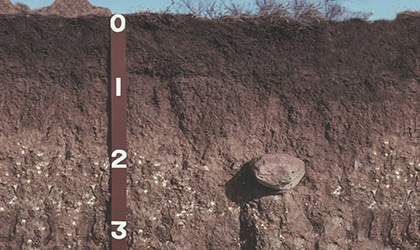January 21, 2017

By Anthony Bly and Sara Berg
About Gypsum
The consideration of gypsum as a soil amendment has become a popular topic in crop production agriculture. However, correctly understanding the chemical function of gypsum and lime in soil is needed to properly place this amendment. Gypsum, which is calcium sulfate (CaSO4) after applied to the soil and dissolved in the water it disassociates into calcium (Ca2+) and sulfate (SO4-). Typically, when low pH is a problem in South Dakota soils, the hydrogen ion (H+) is the culprit. In highly weathered, older soils typically found in southern states beyond the reach of past glaciation, aluminum (Al3+) is more often than not the cause of lower pH. However, in South Dakota soils, the weathering process, (a breakdown of larger to smaller soil particles) is not as advanced and aluminum (Al3+) is not contributing to lower soil pH. Most South Dakota soils contain free lime and gypsum in their profile. Figure 1 shows lime concretions at about the 2 foot depth; gypsum crystals are harder to see, but some soils have layers with high concentrations as well.
Effects on Soil
The acidification of soil happens when hydrogen (H+) ions are produced from nitrification of nitrogen-containing fertilizers. This process creates small amounts of acidity (H+) and over time, the soil pH can drop to levels where lime application is needed. Lime is the right soil amendment to correct soil acidity in South Dakota because hydrogen (H+) is causing the acidity in our soils, and therefore lime (CaCO3) needs to be added. The chemical reaction with lime and soil acidity (H+) can be complicated for those not familiar with chemical equilibria. In this reaction, the hydrogen (H+) ion reacts with the carbonate (CO3) from the lime (CaCO3) to form carbonic acid which dissociates into water (H2O) and carbon dioxide (CO2) and is released to the atmosphere as a gas. The calcium in lime then replaces the acidity (H+) on the soil cation exchange site. Therefore, lime is suggested, but gypsum is not recommended for soil pH correction in SD.
When and where to use it?
Gypsum, however, has been recommended in other states for sodium affected soil remediation. The calcium in gypsum, if applied at a high enough rate (determined from detailed soil sampling and recommendation equations reviewed in reference below) will replace the sodium on the soil cation exchange sites and form sodium sulfate (NaSO4) that leaches from the soil if good drainage exists. South Dakota on-farm research has not verified or demonstrated successful use of gypsum for sodium affected soil remediation, however several sites are currently under investigation. Other perceived uses for gypsum such as reducing soil bulk density, increasing water infiltration, decreasing soil crusting, balancing soil cation ratios, and making a meaningful influence on iron chlorosis in soybeans have not been successfully verified with research methods. Conversely, gypsum as a sulfur nutrient source has been very successfully demonstrated through research. However, it has much lower solubility than ammonium sulfate and therefore should be considered if plant sulfur demand is urgent. To review a more in-depth discussion about gypsum use in the North Central region, please read Effectiveness of Gypsum in the North-central Region of the U.S.
Originally posted by South Dakota State University.
You May Also Like




